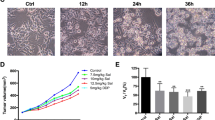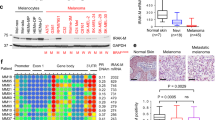Abstract
The molecular causes for resistance of melanoma to apoptosis are currently only partly understood. In the present study, we examined gene transfer and expression of the proapoptotic BH3-only protein Noxa as an alternative approach to chemotherapy and investigated the molecular mechanisms regulating Noxa-induced apoptosis. Noxa gene transfer caused dysregulation of both mitochondria and, as shown for the first time, also the endoplasmic reticulum, resulting in the accumulation of reactive oxygen species. Interestingly, expression of Noxa not only triggered the classical mitochondrial caspase cascade, but also resulted in the activation of apoptosis signal-regulating kinase1 and its downstream effectors c-Jun N-terminal kinase and p38. The activation of these kinases was abolished by antioxidants. Moreover, inhibition of the kinases by RNA interference or pharmacological inhibitors significantly attenuated Noxa-induced apoptosis. Thus, our data provide evidence for the involvement of multiple pathways in Noxa-induced apoptosis that are triggered at mitochondria and the endoplasmic reticulum, and suggest Noxa gene transfer as a complementary approach to chemotherapy.
This is a preview of subscription content, access via your institution
Access options
Subscribe to this journal
Receive 50 print issues and online access
$259.00 per year
only $5.18 per issue
Buy this article
- Purchase on Springer Link
- Instant access to full article PDF
Prices may be subject to local taxes which are calculated during checkout








Similar content being viewed by others
References
Adler V, Yin Z, Tew KD, Ronai Z . (1999). Role of redox potential and reactive oxygen species in stress signaling. Oncogene 18: 6104–6111.
Akao Y, Otsuki Y, Kataoka S, Ito Y, Tsujimoto Y . (1994). Multiple subcellular localization of bcl-2: detection in nuclear outer membrane, endoplasmic reticulum membrane, and mitochondrial membranes. Cancer Res 54: 2468–2471.
Cai J, Yang J, Jones DP . (1998). Mitochondrial control of apoptosis: the role of cytochrome c. Biochim Biophys Acta 1366: 139–149.
Chen L, Willis SN, Wei A, Smith BJ, Fletcher JI, Hinds MG et al. (2005). Differential targeting of prosurvival Bcl-2 proteins by their BH3-only ligands allows complementary apoptotic function. Mol Cell 17: 393–403.
Chun AC, Jin DY . (2003). Transcriptional regulation of mitotic checkpoint gene MAD1 by p53. J Biol Chem 278: 37439–37450.
Daniel PT, Schulze-Osthoff K, Belka C, Guner D . (2003). Guardians of cell death: the Bcl-2 family proteins. Essays Biochem 39: 73–88.
Deniaud A, Sharaf El Dein O, Maillier E, Poncet D, Kroemer G, Lemaire C et al. (2007). Endoplasmic reticulum stress induces calcium-dependent permeability transition, mitochondrial outer membrane permeabilization and apoptosis. Oncogene 27: 274–284.
Duan WR, Garner DS, Williams SD, Funckes-Shippy CL, Spath IS, Blomme EA . (2003). Comparison of immunohistochemistry for activated caspase-3 and cleaved cytokeratin 18 with the TUNEL method for quantification of apoptosis in histological sections of PC-3 subcutaneous xenografts. J Pathol 199: 221–228.
Eferl R, Wagner EF . (2003). AP-1: a double-edged sword in tumorigenesis. Nat Rev Cancer 3: 859–868.
Essmann F, Bantel H, Totzke G, Engels IH, Sinha B, Schulze-Osthoff K et al. (2003). Staphylococcus aureus alpha-toxin-induced cell death: predominant necrosis despite apoptotic caspase activation. Cell Death Differ 11: 1260–1272.
Essmann F, Pohlmann S, Gillissen B, Daniel PT, Schulze-Osthoff K, Janicke RU . (2005). Irradiation-induced translocation of p53 to mitochondria in the absence of apoptosis. J Biol Chem 280: 37169–37177.
Estus S, Zaks WJ, Freeman RS, Gruda M, Bravo R, Johnson Jr EM . (1994). Altered gene expression in neurons during programmed cell death: identification of c-jun as necessary for neuronal apoptosis. J Cell Biol 127: 1717–1727.
Fernandez Y, Verhaegen M, Miller TP, Rush JL, Steiner P, Opipari Jr AW et al. (2005). Differential regulation of noxa in normal melanocytes and melanoma cells by proteasome inhibition: therapeutic implications. Cancer Res 65: 6294–6304.
Gillissen B, Essmann F, Graupner V, Starck L, Radetzki S, Dorken B et al. (2003). Induction of cell death by the BH3-only Bcl-2 homolo Nbk/Bik is mediated by an entirely Bax-dependent mitochondrial pathway. EMBO J 22: 3580–3590.
Gomez-Bougie P, Wuillème-Toumi S, Ménoret E, Trichet V, Robillard N, Philippe M et al. (2007). Noxa up-regulation and Mcl-1 cleavage are associated to apoptosis induction by bortezomib in multiple myeloma. Cancer Res 67: 5418–5424.
Hassan M, Ghozlan H, Abdel-Kader O . (2004). Activation of RB/E2F signaling pathway is required for the modulation of hepatitis C virus core protein-induced cell growth in liver and non-liver cells. Cell Signal 16: 1375–1385.
Hassan M, Ghozlan H, Abdel-Kader O . (2005a). Activation of c-Jun NH2-terminal kinase (JNK) signaling pathway is essential for the stimulation of hepatitis C virus (HCV) non-structural protein 3 (NS3)-mediated cell growth. Virology 333: 324–336.
Hassan M, Mirmohammadsadegh A, Selimovic D, Nambiar S, Tannapfel A, Hengge UR . (2005b). Identification of functional genes during Fas-mediated apoptosis using a randomly fragmented cDNA library. Cell Mol Life Sci 62: 2015–2026.
Hassan M, Selimovic D, Ghozlan H, Abdel-Kader O . (2007). Induction of high-molecular-weight (HMW) tumor necrosis factor (TNF) alpha by hepatitis C virus (HCV) non-structural protein 3 (NS3) in liver cells is AP-1 and NF-kappaB-dependent activation. Cell Signal 19: 301–311.
Hershko T, Ginsberg D . (2004). Up-regulation of Bcl-2 homology 3 (BH3) only proteins by E2F1 mediates apoptosis. J Biol Chem 279: 8627–8634.
Horiuchi H, Ogata T, Morino T, Chuai M, Yamamoto H . (2003). Continuous intrathecal infusion of SB203580, a selective inhibitor of p38 mitogen-activated protein kinase, reduces the damage of hind-limb function after thoracic spinal cord injury in rat. Neurosci Res 47: 209–217.
Hossini AM, Eberle J, Fecker LF, Orfanos CE, Geilen CC . (2003). Conditional expression of exogenous Bcl-X(S) triggers apoptosis in human melanoma cells in vitro and delays growth of melanoma xenografts. FEBS Lett 553: 250–256.
Hossini AM, Geilen CC, Fecker LF, Daniel PT, Eberle J . (2006). A novel Bcl-x splice product, Bcl-xAK, triggers apoptosis in human melanoma cells without BH3 domain. Oncogene 25: 2160–2169.
Ichijo H, Nishida E, Irie K, ten Dijke P, Saitoh M, Moriguchi M et al. (1997). Induction of apoptosis by ASK1, a mammalian MAPKKK that activates SAPK/JNK and p38 signaling pathways. Science 275: 90–94.
Kim JY, Ahn HJ, Ryu JH, Suk K, Park JH . (2004). BH3-only protein Noxa is a mediator of hypoxic cell death induced by hypoxia-inducible factor 1alpha. J Exp Med 199: 113–124.
Labi V, Erlacher M, Kiessling S, Villunger A . (2006). BH3-only proteins in cell death initiation, malignant disease and anticancer therapy. Cell Death Differ 13: 1325–1338.
Lee AS . (2001). The glucose-regulated proteins: stress induction and clinical applications. Trends Biochem Sci 26: 504–510.
Lindsten T, Ross AJ, King A, Zong WX, Rathmell JC, Shiels HA et al. (2000). The combined functions of proapoptotic Bcl-2 family members bak and bax are essential for normal development of multiple tissues. Mol Cell 6: 1389–1399.
Los M, Schenk H, Hexel K, Baeuerle PA, Dröge W, Schulze-Osthoff K . (1995). IL-2 gene expression and NF-kappaB activation through CD28 requires reactive oxygen production by 5-lipoxygenase. EMBO J 14: 3731–3740.
Oda E, Ohki R, Murasawa H, Nemoto J, Shibue T, Yamashita T et al. (2000). Noxa, a BH3-only member of the Bcl-2 family and candidate mediator of p53-induced apoptosis. Science 288: 1053–1058.
Oppermann M, Geilen CC, Fecker LF, Gillissen B, Daniel PT, Eberle J . (2005). Caspase-independent induction of apoptosis in human melanoma cells by the proapoptotic Bcl-2-related protein Nbk/Bik. Oncogene 24: 7369–7380.
Pardo J, Urban C, Galvez EM, Ekert PG, Müller U, Kwon-Chung J et al. (2006). The mitochondrial protein Bak is pivotal for gliotoxin-induced apoptosis and a critical host factor of Aspergillus fumigatus virulence in mice. J Cell Biol 174: 509–519.
Pérez-Galán P, Roué G, Villamor N, Campo E, Colomer D . (2007). The BH3-mimetic GX15-070 synergizes with bortezomib in mantle cell lymphoma by enhancing Noxa-mediated activation of Bak. Blood 109: 4441–4449.
Qin JZ, Stennett L, Bacon P, Bodner B, Hendrix MJ, Seftor RE et al. (2004). P53-independent NOXA inductions overcome apoptotic resistance of malignant melanomas. Mol Cancer Ther 3: 895–902.
Qin JZ, Xin H, Sitailo LA, Denning MF, Nickoloff BJ . (2006). Enhanced killing of melanoma cells by simultaneously targeting Mcl-1 and NOXA. Cancer Res 66: 9636–9645.
Reed JC . (2006). Proapoptotic multidomain Bcl-2/Bax-family proteins: mechanisms, physiological roles, and therapeutic opportunities. Cell Death Differ 13: 1378–1386.
Samraj AK, Sohn D, Schulze-Osthoff K, Schmitz I . (2007). Loss of caspase-9 reveals its essential role for caspase-2 activation and mitochondrial membrane depolarization. Mol Biol Cell 18: 84–93.
Scorrano L, Oakes SA, Opferman JT, Cheng EH, Sorcinelli MD, Pozzan T et al. (2003). BAX and BAK regulation of endoplasmic reticulum Ca2+: a control point for apoptosis. Science 300: 135–139.
Shibue T, Takeda K, Oda E, Tanaka H, Murasawa H, Takaoka A et al. (2003). Integral role of Noxa in p53-mediated apoptotic response. Genes Dev 17: 2233–2238.
Soengas MS, Capodieci P, Polsky D, Mora J, Esteller M, Opitz-Araya X et al. (2001). Inactivation of the apoptosis effector Apaf-1 in malignant melanoma. Nature 409: 207–211.
Soengas MS, Lowe SW . (2003). Apoptosis and melanoma chemoresistance. Oncogene 22: 3138–3151.
Tobiume K, Matsuzawa A, Takahashi T, Nishitoh H, Morita K, Takeda K et al. (2001). ASK1 is required for sustained activations of JNK/p38 MAP kinases and apoptosis. EMBO Rep 3: 222–228.
Villunger A, Michalak EM, Coultas L, Müllauer F, Böck G, Ausserlechner MJ et al. (2003). p53- and drug-induced apoptotic responses mediated by BH3-only proteins puma and noxa. Science 302: 1036–1038.
Wei MC, Zong WX, Cheng EH, Lindsten T, Panoutsakopoulou V, Ross AJ et al. (2001). Proapoptotic BAX and BAK: a requisite gateway to mitochondrial dysfunction and death. Science 292: 727–730.
Willis SN, Fletcher JI, Kaufmann T, van Delft MF, Chen L, Czabotar PE et al. (2007). Apoptosis initiated when BH3 ligands engage multiple Bcl-2 homologs, not Bax or Bak. Science 315: 856–859.
Zanke BW, Boudreau K, Rubie E, Winnett E, Tibbles LA, Zon L et al. (1996). The stress-activated protein kinase pathway mediates cell death following injury induced by cis-platinum, UV irradiation or heat. Curr Biol 6: 606–613.
Zong WX, Li C, Hatzivassiliou G, Lindsten T, Yu QC, Yuan J et al. (2003). Bax and Bak can localize to the endoplasmic reticulum to initiate apoptosis. J Cell Biol 162: 59–69.
Acknowledgements
This work was supported by the Dr Mildred Scheel Foundation to M Hassan (Ha1 10-2202).
Author information
Authors and Affiliations
Corresponding author
Rights and permissions
About this article
Cite this article
Hassan, M., Alaoui, A., Feyen, O. et al. The BH3-only member Noxa causes apoptosis in melanoma cells by multiple pathways. Oncogene 27, 4557–4568 (2008). https://doi.org/10.1038/onc.2008.90
Received:
Revised:
Accepted:
Published:
Issue Date:
DOI: https://doi.org/10.1038/onc.2008.90
Keywords
This article is cited by
-
Melanoma stem cell maintenance and chemo-resistance are mediated by CD133 signal to PI3K-dependent pathways
Oncogene (2020)
-
Stress and interferon signalling-mediated apoptosis contributes to pleiotropic anticancer responses induced by targeting NGLY1
British Journal of Cancer (2018)
-
Gold nanoparticles induce cell death and suppress migration of melanoma cells
Journal of Nanoparticle Research (2017)
-
Interferon gamma-induced apoptosis of head and neck squamous cell carcinoma is connected to indoleamine-2,3-dioxygenase via mitochondrial and ER stress-associated pathways
Cell Division (2016)
-
SOX30, a novel epigenetic silenced tumor suppressor, promotes tumor cell apoptosis by transcriptional activating p53 in lung cancer
Oncogene (2015)



